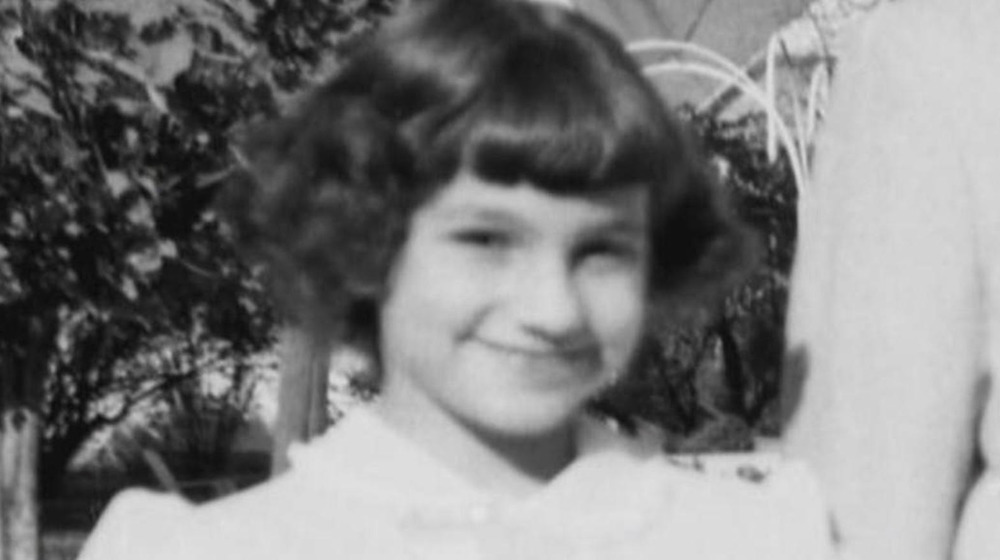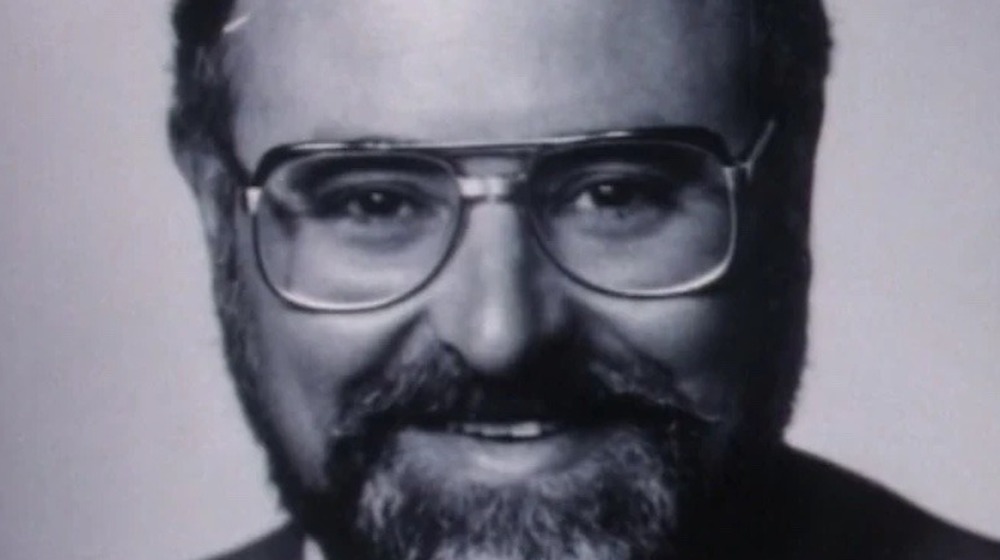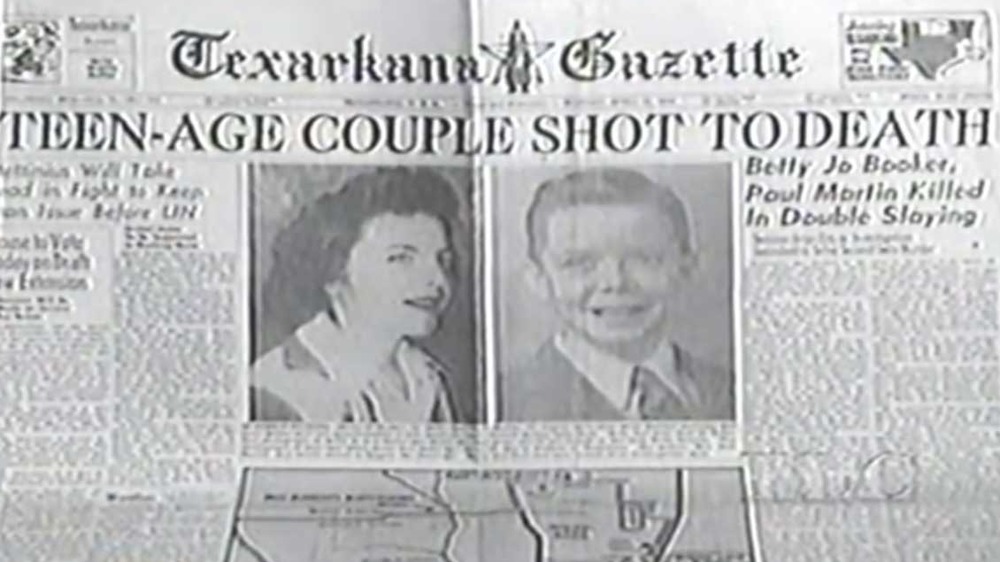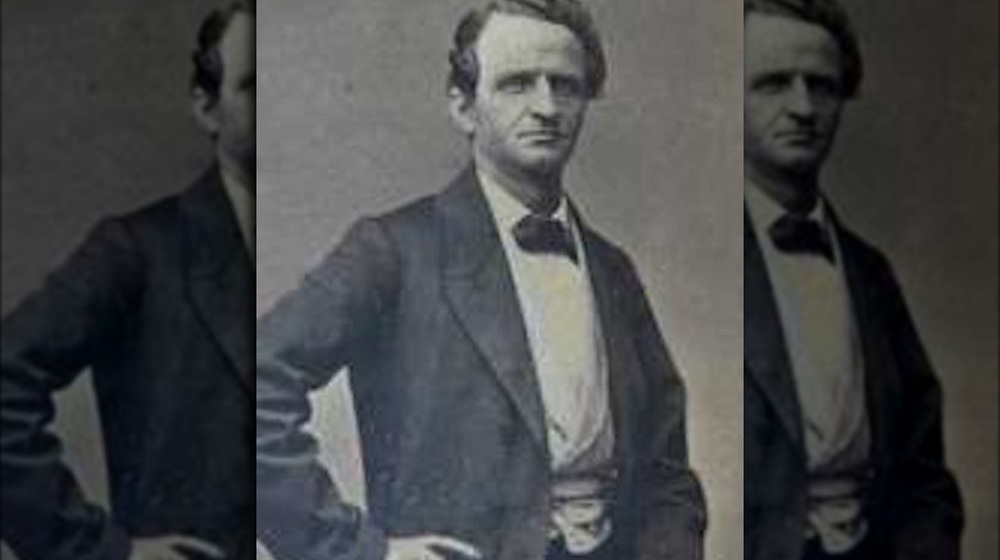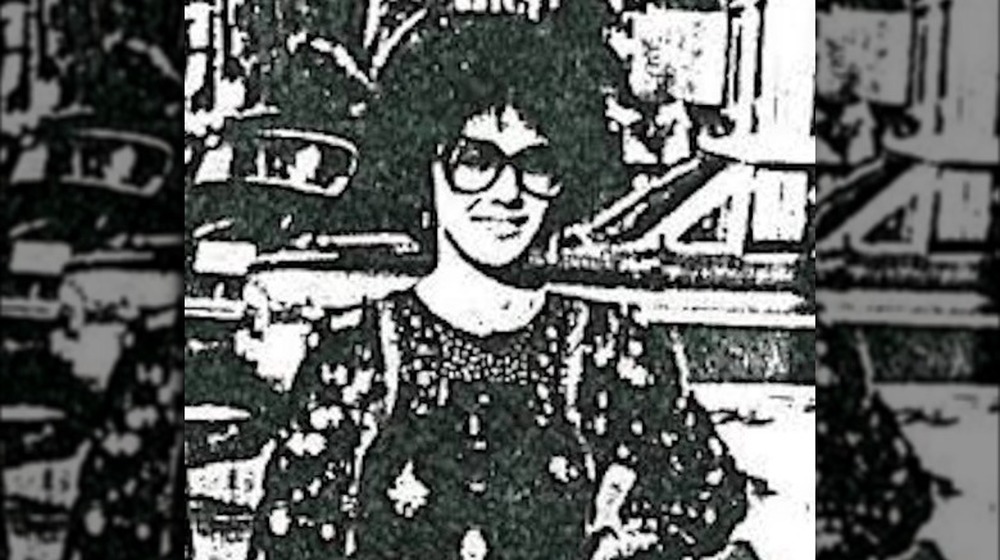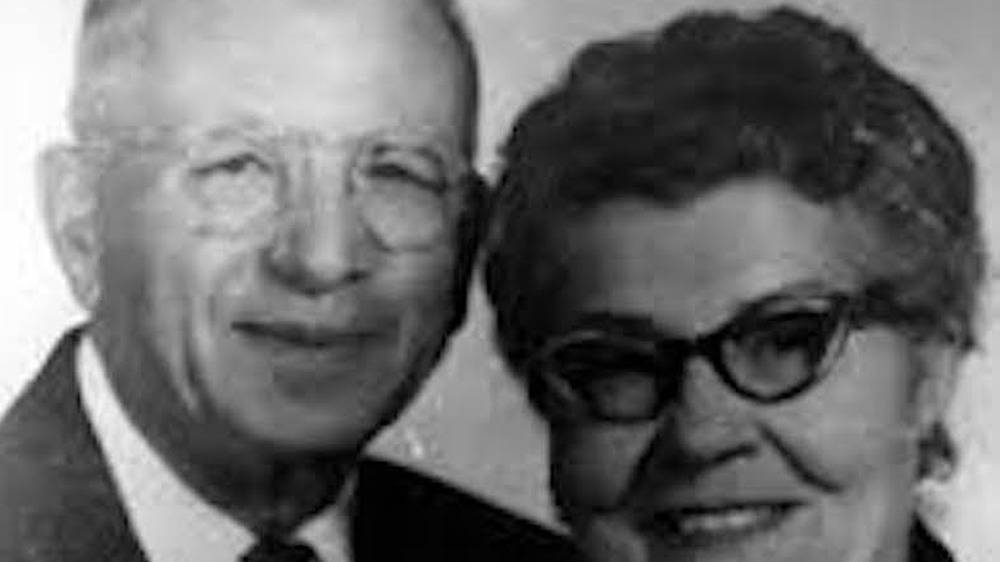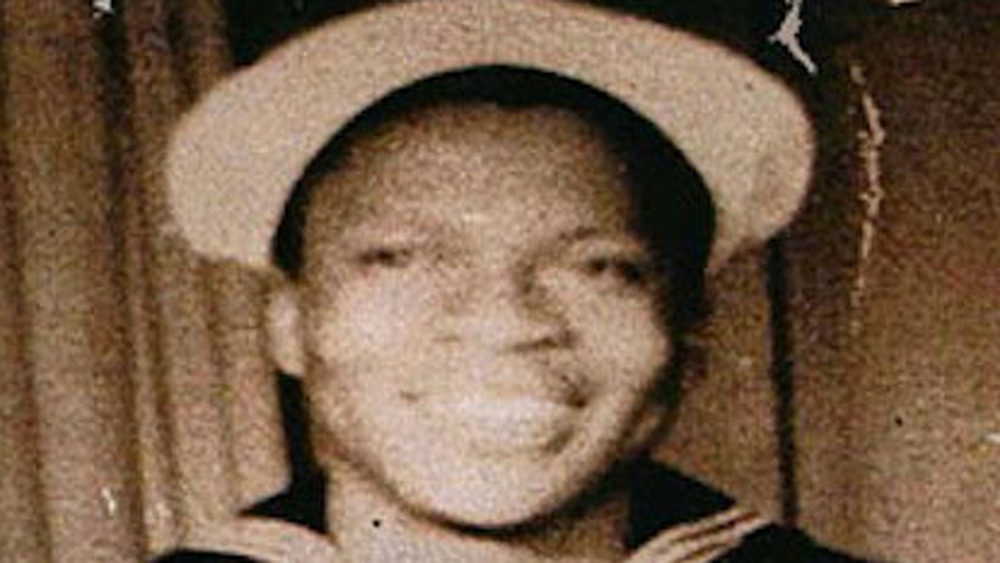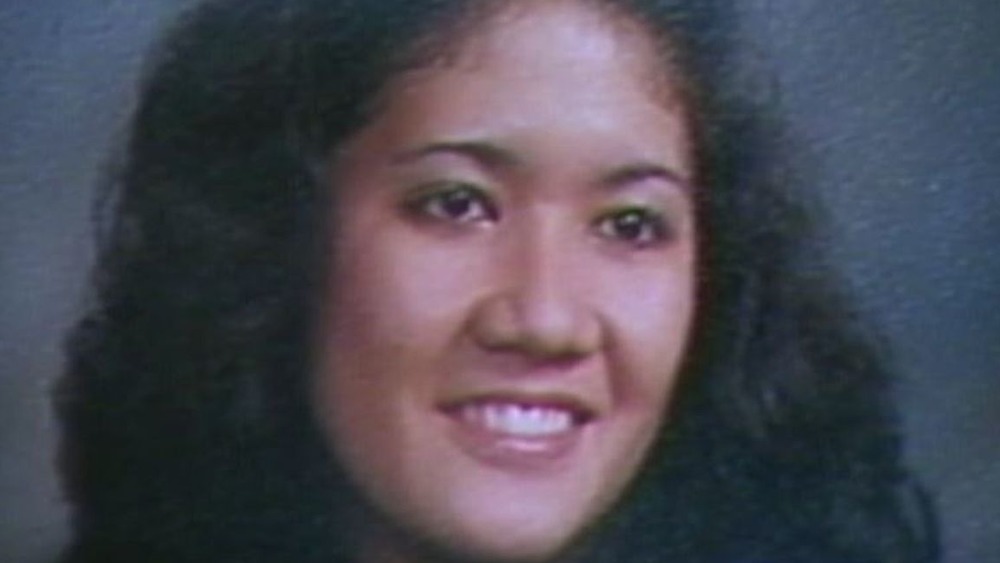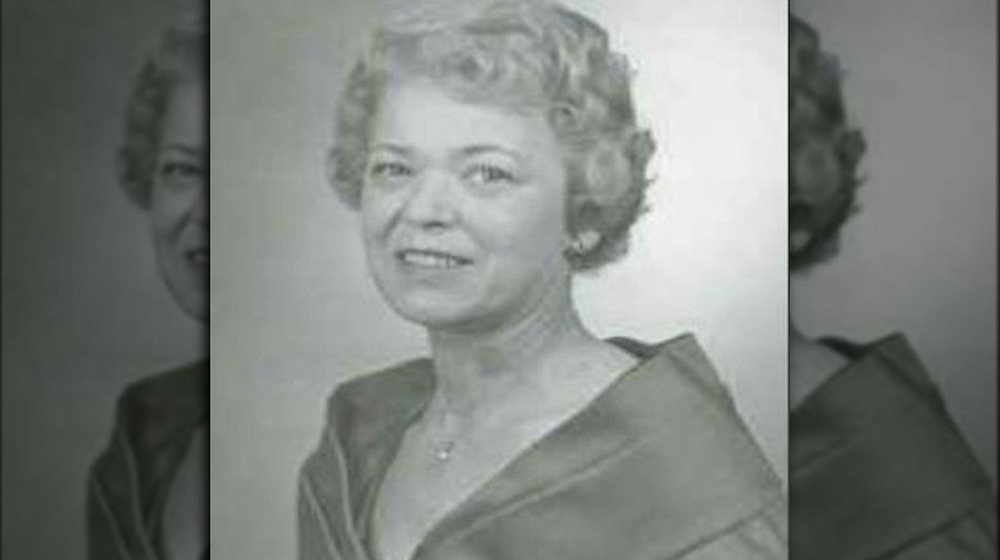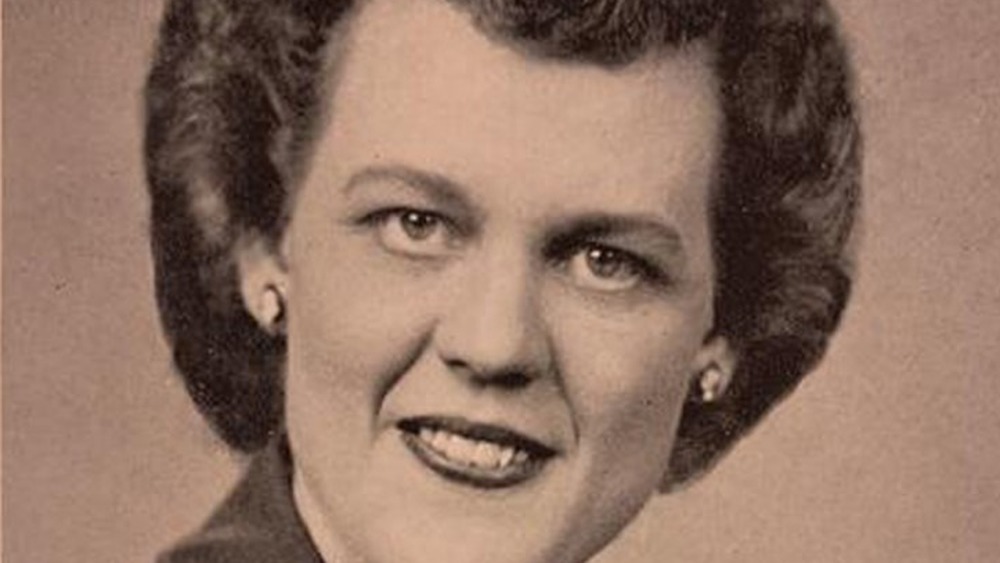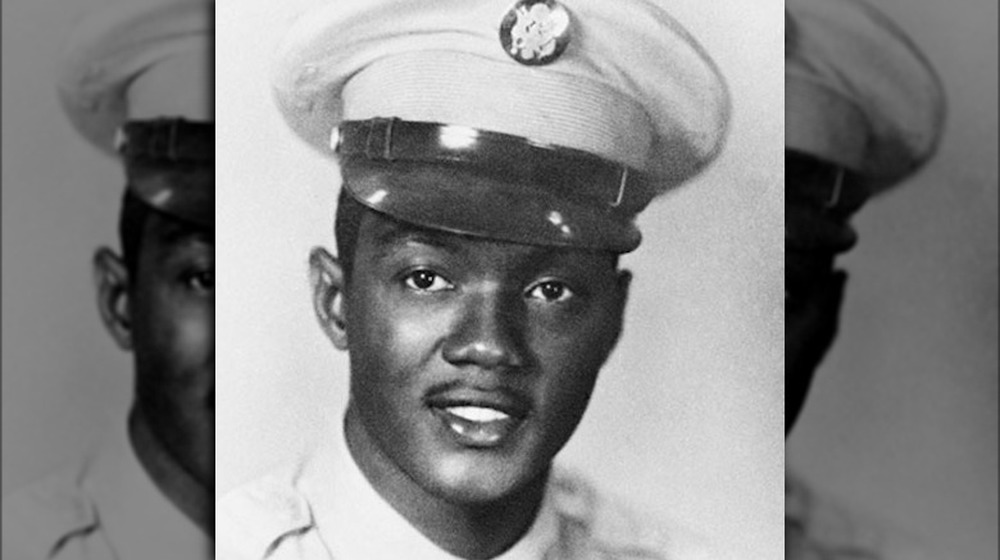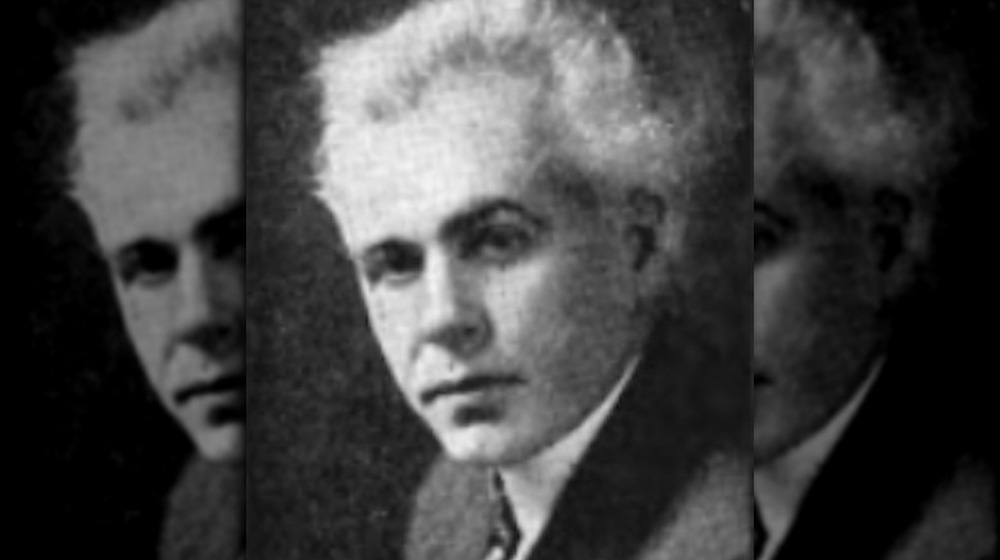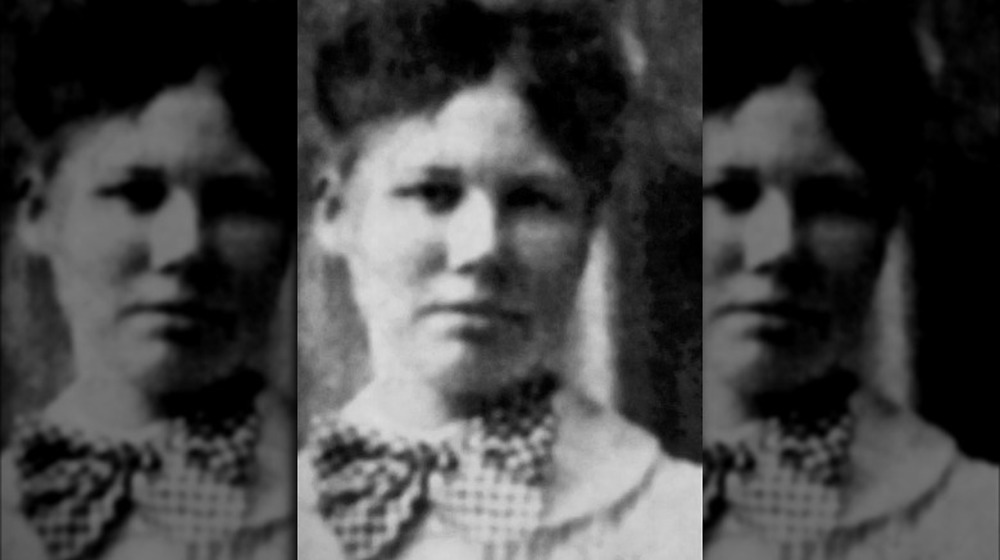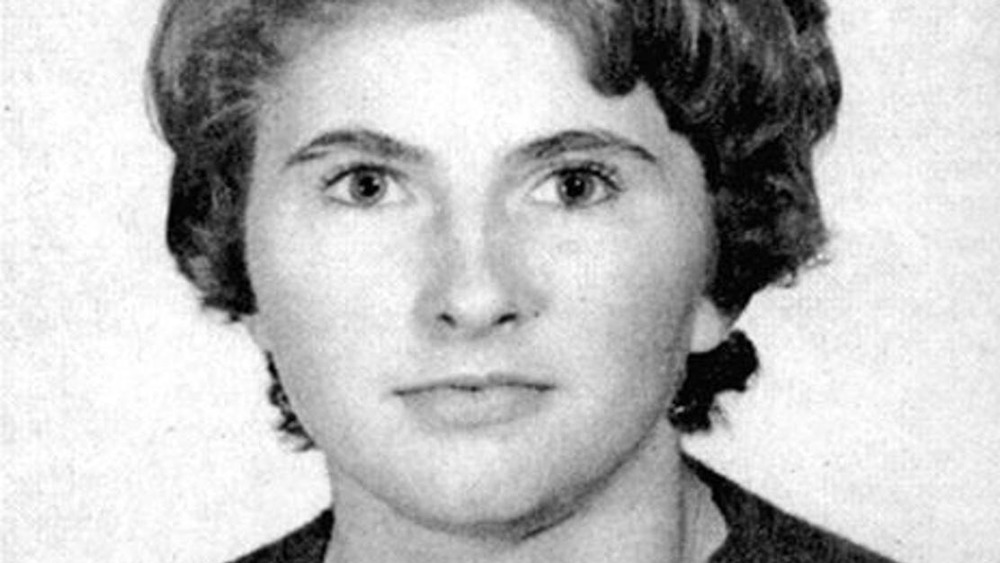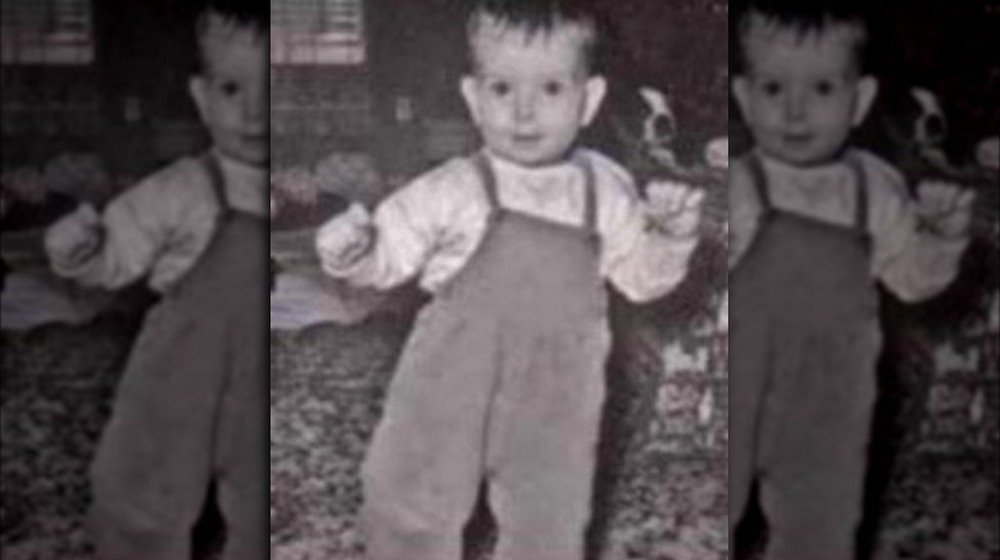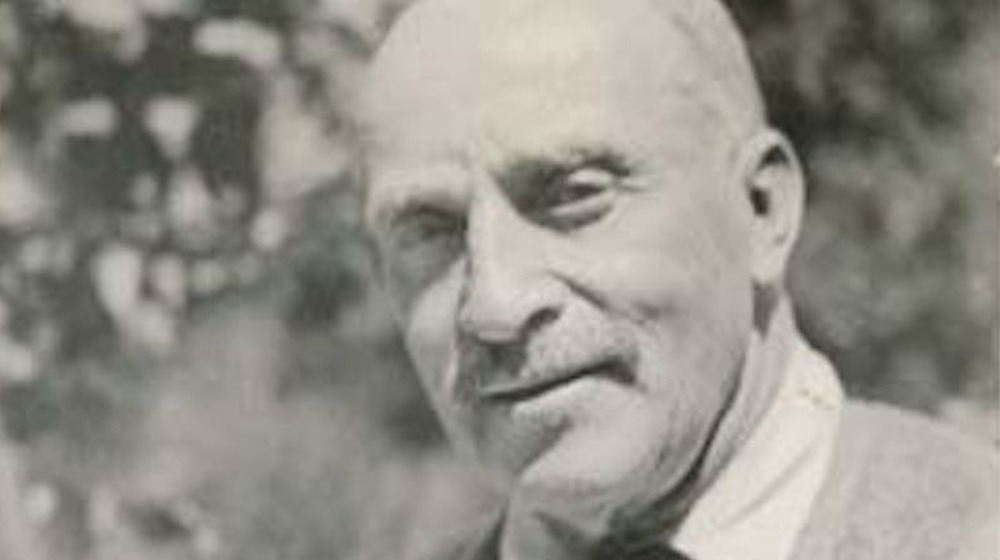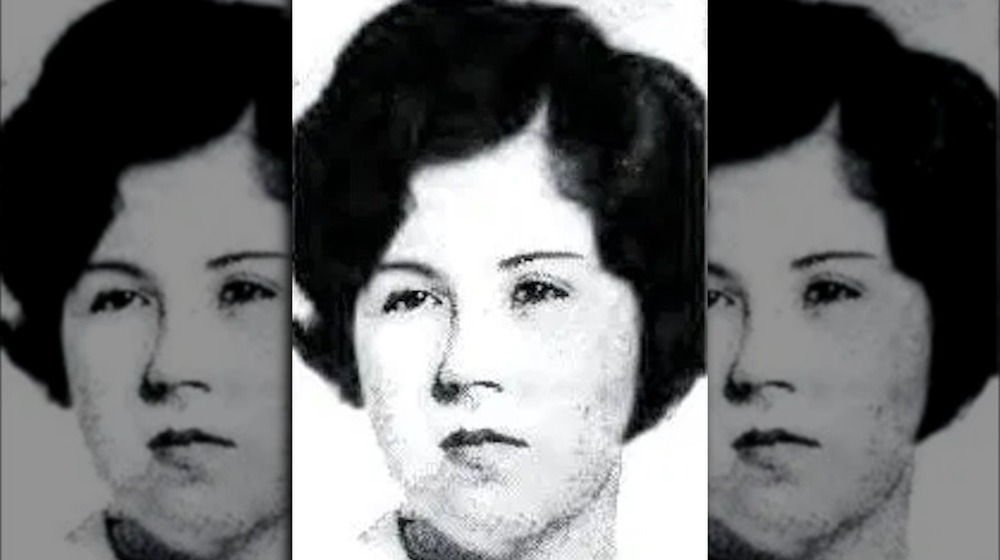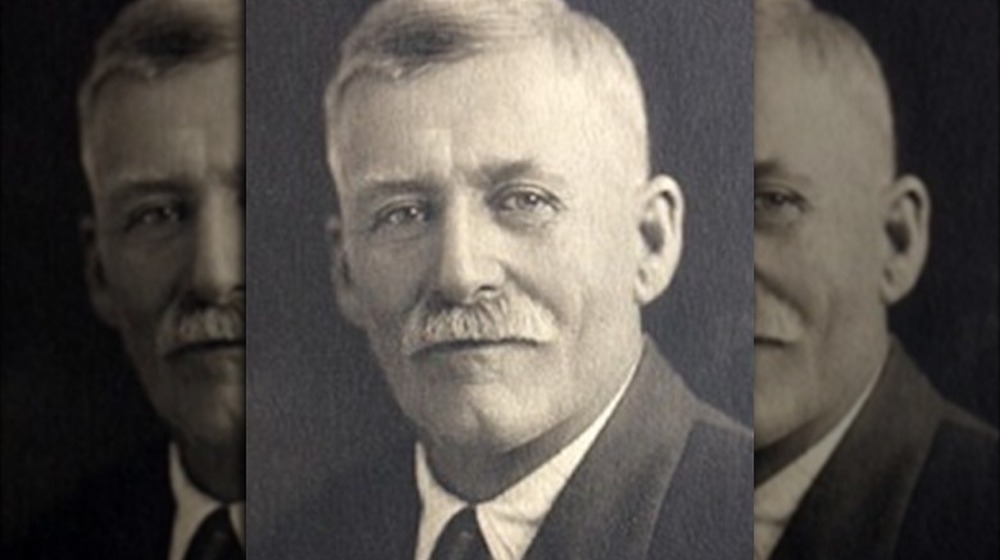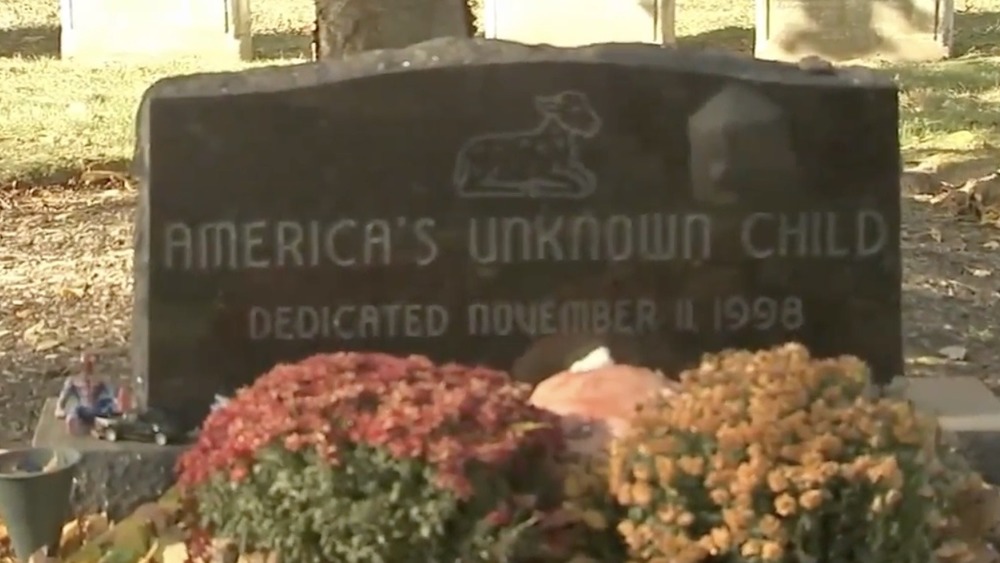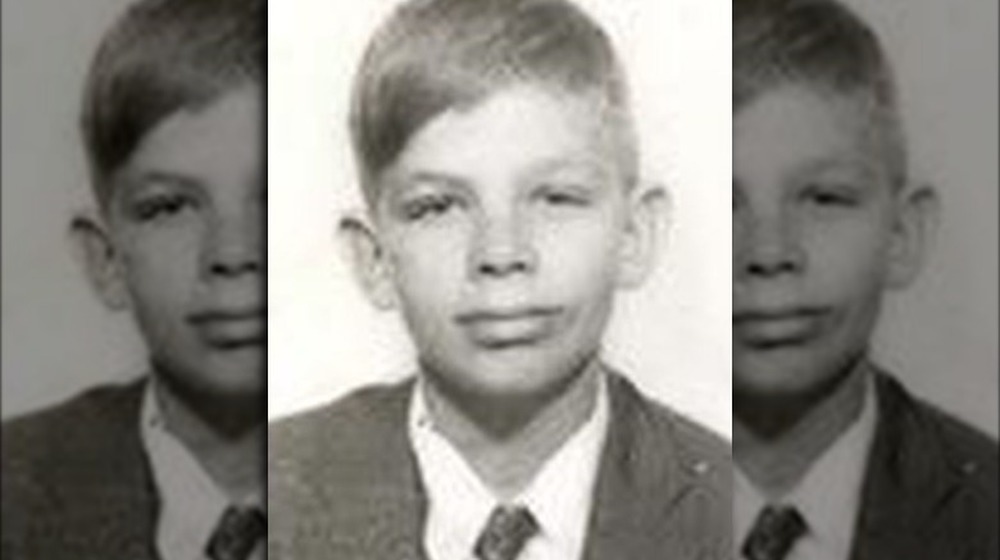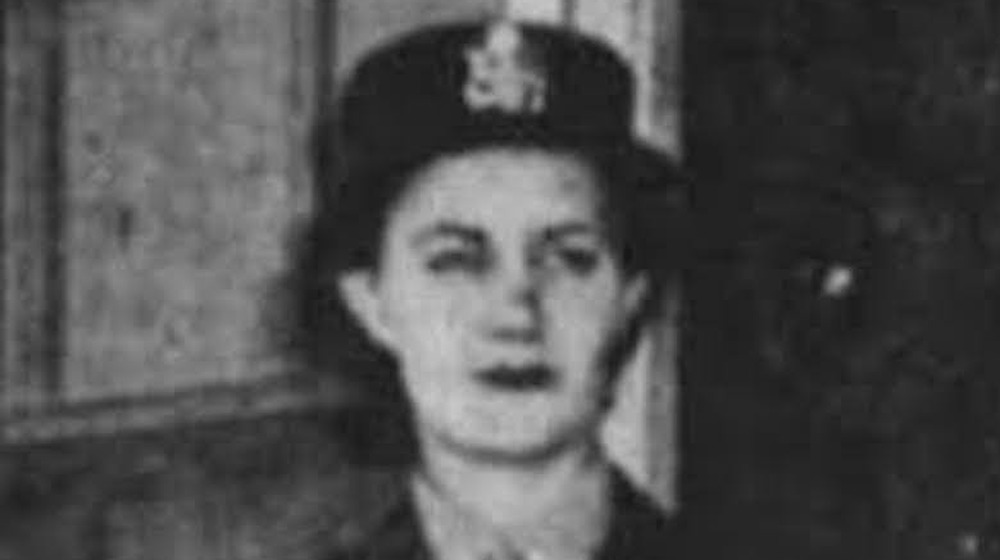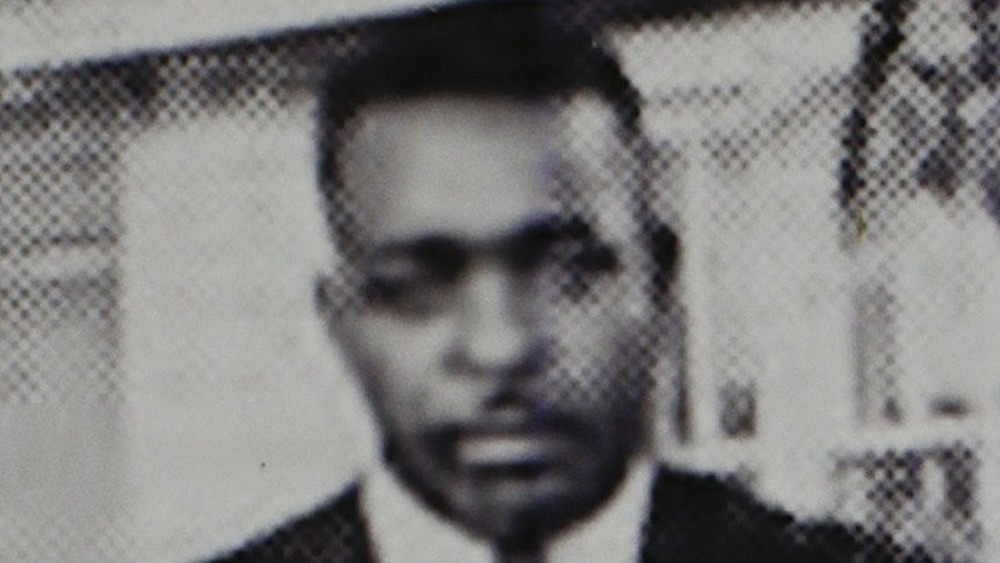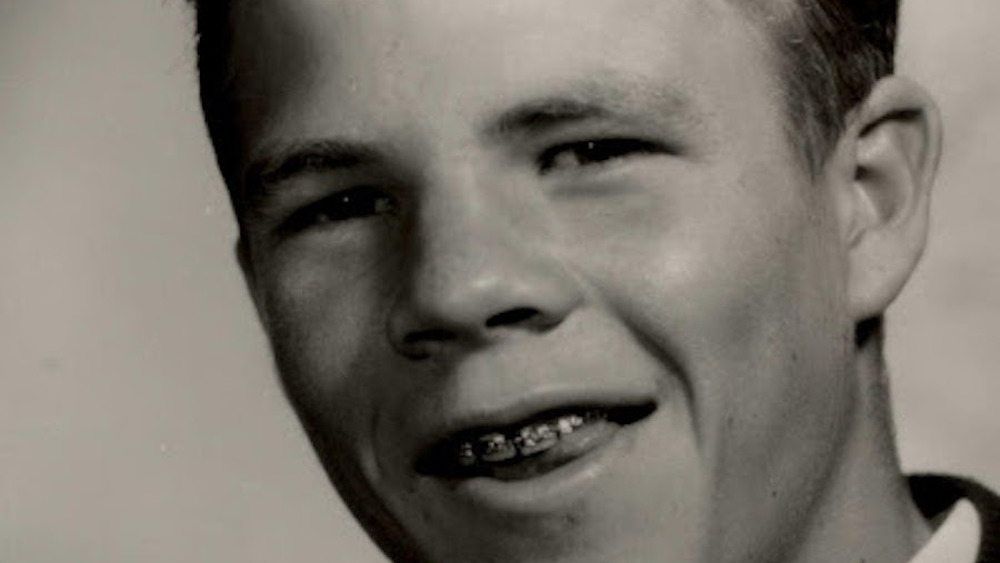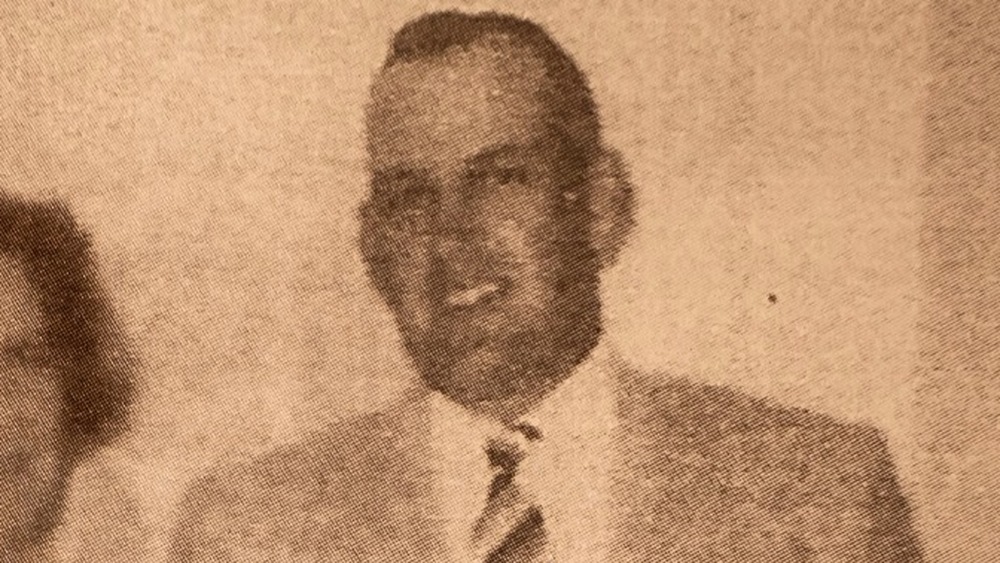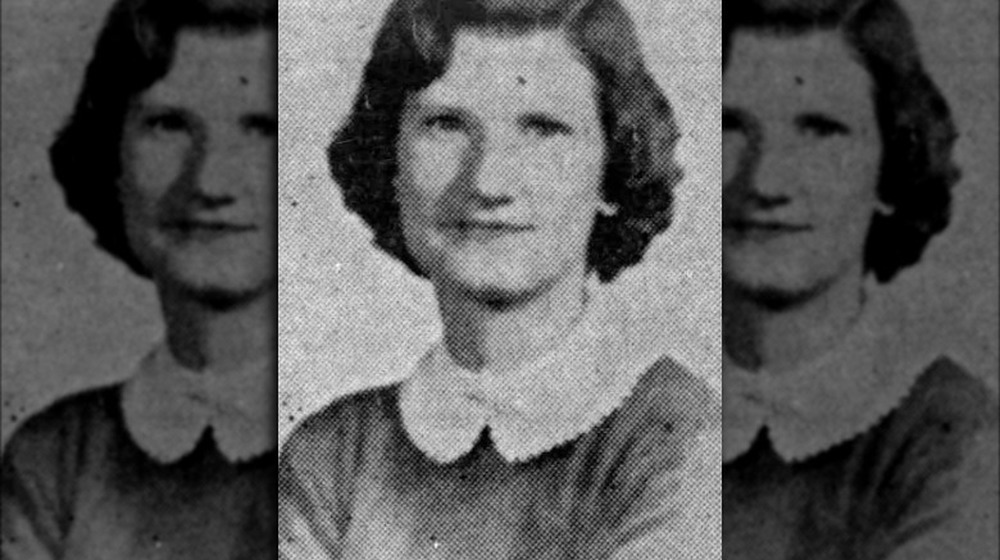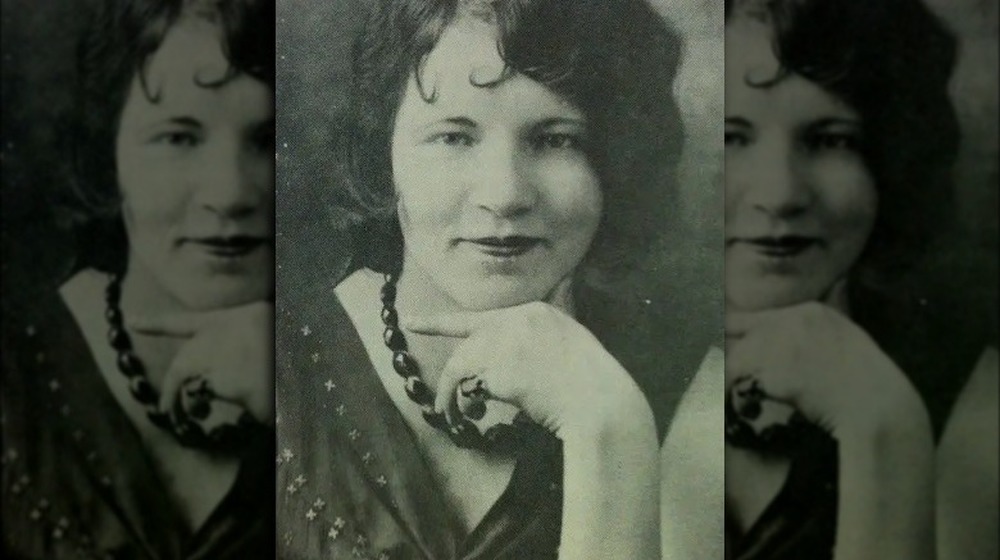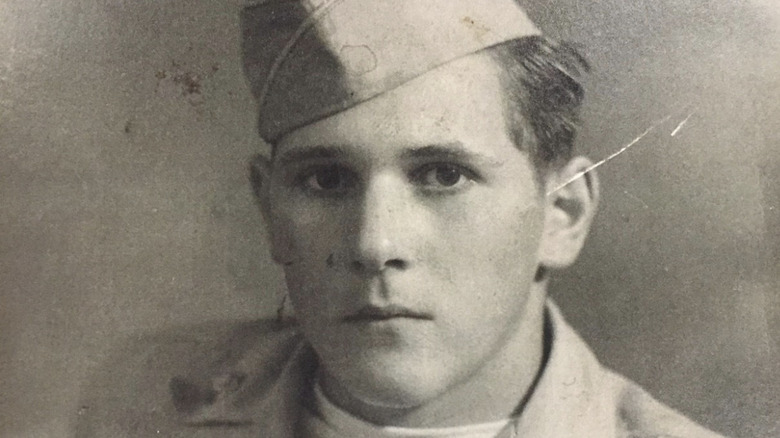The Oldest Cold Case From Every State
Conventional wisdom says there's no such thing as the perfect crime. But from a technical, historical point of view, there is. It's a sad and unfortunate fact of life, both today and throughout the past, that some criminals completely get away with their transgression against society and their fellow humans, taking the secret of their reprehensible acts to the grave. Even the worst of criminal actions — murder, assault, kidnapping, mutilation — may go unpunished, despite mountains of evidence and eyewitness testimony, leaving survivors left to reckon with the devastating consequences.
It's not for a lack of trying on account of police departments and other law enforcement operations. Detectives work tirelessly to find murderers and other criminals so as to bring them to justice, but sometimes they just can't find the perpetrator or get charges to stick. Every state in the country has experienced crimes of this nature, with some cases staying open for years, decades, or even indefinitely. Here are some crimes that are among each of the 50 states' oldest, most serious, and still occasionally investigated — the ones that haunt families, communities, and investigators. (Warning: Many of these cases are sad, violent, and very unsettling, so proceed with caution.)
Alabama: Sandra Williams
According to Alabama's cold case unit, the state's oldest and most unsolved serious crime is the disappearance of Sandra Williams. On the morning of Sept. 11, 1980, the body of Williams, 20 years old, was found in a cul-de-sac in Mobile, with police quickly ruling the cause of death to be murder by stabbing. Per the Atlanta Journal-Constitution, that was eight miles from Williams' apartment, where her car remained in its parking spot. There was no sign of struggle in her residence, although the door had been left open. It was a mysterious death, which led to a fruitless investigation, at least at first.
In the 2010s, Mobile police took another look at Williams' case, re-interviewing as many witnesses as they could find and using technology not at their disposal in 1980 to examine evidence. DNA led to a secret indictment of Alvin Ray Allen, arrested on a murder charge in 2019 after a standoff with police and the involvement of a SWAT team. In 2020, Williams' court appearance resulted in a hung jury and a mistrial, making this murder case cold once more.
Alaska: Beth van Zanten
One of the longest unsolved crimes in Alaska has baffled law enforcement for decades, in part because officials can't connect it to one of the state's most notorious murderers. According to The Lineup, on Christmas Day 1971, brothers Dennis and Gary Lawler went to McHugh Creek State Park for a wilderness photo shoot. Dennis Lawler found a small ledge about 20 feet below a picnic area, a steep overlook and ideal spot to photograph a waterfall. As he set up his shot, he spotted what he thought at first glance was a snow-covered mannequin dumped behind a bush. It wasn't a mannequin — it was the abandoned corpse of a human being.
State troopers recovered the body, unclothed from the waist down, hands tied with speaker wire, the chest slashed, and identified her as Celia "Beth" van Zanten, an 18-year-old Anchorage woman reported missing after a trip to a convenience store two days earlier. The murderer hadn't fully killed her — the party had assaulted and attacked van Zanten, but she'd gotten away at McHugh Creek State Park and ran away, only to fall off a ledge and freeze to death.
Anchorage police interviewed residents of van Zanten's neighborhood and her family. The most logical suspect, a foster cousin, had an alibi — he'd been stopped by police for drunkennesses around the time van Zanten disappeared. Later, Robert Hansen, a serial killer who admitted to 17 murders in the 1970s and 1980s, wouldn't claim responsibility for van Zanten's death.
Arizona: Charles Morgan
According to All That's Interesting, Tucson financial manager Chuck Morgan left for work on the morning of March 22, 1977... and then didn't come home for three days. He wasn't exactly safe and sound, either — he let his wife know that a mysterious party had treated his throat with a drug that could kill him if he attempted to speak. Morgan also claimed to be a secret agent of the U.S. Treasury.
He recovered within a week, but then two months later, Morgan once again disappeared. Nine days after that, Morgan's wife received a mysterious phone call, where a female voice told her that her husband was "all right," but he obviously wasn't when two days later, Morgan's body was found in the desert 40 miles west of Tucson. The cause of death — a gunshot to the back of the head, oddly from his own gun.
In Morgan's car, authorities found more weapons, ammunition, and one of Morgan's teeth wrapped in a handkerchief. Morgan was wearing a bulletproof vest and had a $2 bill clipped to his underwear with some last names scrawled on it. As the investigation intensified, a woman identifying herself as "Green Eyes" (the same individual who called Morgan's wife) phoned the Pima County Sheriff's office with a tip that Morgan had tried to pay off an assassin who'd been hired to kill him, and that the deceased had some organized crime ties. And that's where the story ends — Morgan's strange murder was never solved.
Arkansas: The Phantom Killer
Over a period of ten weeks in 1946, per Texas Monthly, couples in "Lover's Lane"-type areas in the adjoining border towns of Texarkana, Ark., and Texarkana, Texas, were terrorized by a murderer who came to be known as "The Phantom Killer." That nickname suggests that citizens and law enforcement officials alike didn't know much about the perpetrator, likening him to a ghost. It's still true today, as it's among the oldest unsolved crime sprees in Arkansas history.
All in all The Phantom Killer assaulted eight people on weekends between late February and early May 1946, and five of his victims died via gunshot. According to TXK Today, the assailant's first two targets, Jimmy Hollis and Mary Jeanne Larey, survived. Four weeks later, he'd claim his first lives, with Richard Griffin and Polly Ann Moore, followed by Paul Martin, Betty Jo Booker, and Virgil Starks in the weeks to come. Starks' wife, Katie Starks, survived, although she was seriously wounded in the attack. Texas Rangers sent to the area aggressively patrolled the town, and after three months with no more murders, they left town, just like The Phantom Killer apparently did.
California: Herman Ehrenberg
One of California's oldest — and weirdest — unsolved murders goes back to 1866 and the years after the Gold Rush brought countless treasure-seekers way out west. According to The Press Enterprise, Herman Ehrenberg was an immigrant from Prussia (now part of Germany) who made his fortune as a miner and surveyor and had also fought in the Texas Revolution. He did most of his business in California, and he was traveling via stagecoach from the Arizona border town of Yuma to San Bernardino in the southern part of the state.
He arrived in Dos Palmas on Oct. 9, 1866. There, he slept overnight on a pallet outside the stagecoach station. The stationmaster, W.H. Smith, was sleeping inside, and he would later attest that he heard a gunshot ring out around midnight. When he went outside, he found Ehrenberg shot and dying and also noticed that a few items had been stolen from the station's small general store. One theory at the time held that a man from the local Cahuilla Tribe had attempted to rob Ehrenberg (he had thousands of dollars worth of gold in his pockets to buy a mine), and in 1880, a friend of the deceased suggested that Smith was the guilty party. Nevertheless, his murderer was never identified.
Colorado: Maria Abbatiello-Smith
According to the Colorado Bureau of Investigation, the state's oldest unsolved murder case involves the death of Maria Abbatiello-Smith. In 1977, the 30-year-old worked at the Airman's Club, part of the now-decommissioned Lowry Air Force Base in Denver. Abbatiello-Smith's case began as a missing persons matter, after her disappearance was formally noted on Nov. 20, 1977. Tragically, it would evolve into a homicide case, one that was never conclusively resolved.
Six days after Abbatiello-Smith was reported missing, police responded to a report of a body discovered in a vacant field off Mariposa Street in Denver, not far from where Abbatiello-Smith had lived and worked. An investigation quickly determined that the body was in fact that of Abbatiello-Smith, and that she'd been murdered. However, Denver police were never able to determine who was responsible for the homicide and their reason for the murder. As of 2021, it's still an open case.
Connecticut: Debbie Spickler
The state of Connecticut still has on the books the unsolved case of a teenager who went missing in July 1968. That summer, 13-year-old Debbie Spickler, a resident of Mystic, Conn., went to visit relatives in the city of Vernon. One evening, Spickler and her cousin walked to the swimming pool at Henry Park. Realizing they didn't have towels, Spickler's cousin turned around to go back home on Foxhill Drive to get them, agreeing to meet up with Spickler at the pool. When the cousin arrived at the park, she couldn't find Spickler — she had evidently never arrived.
Spickler wasn't seen or heard from again, with no conclusive evidence of life or death ever uncovered by police, although Spickler's disappearance may be related to two other also unsolved Toiland County abductions that occurred later, in the early 1970s, says the National Center for Missing and Exploited Children. Spickler's case still carries a $50,000 reward for information.
Delaware: an unidentified woman found in 1977
Delaware's oldest unsolved crime is a murder case, and the violent, unnatural way in which the victim died is about the only thing authorities can confidently assert, even after more than 40 years, reports Crimestoppers.
Late in the spring of 1977, a person walking on Old Union Church road in the town of Townsend, Del., noticed a corpse in a drainage ditch by the side of the road. The incident was reported, and police were able to ascertain that the very decomposed body was that of a woman in her mid-40s, in the range of 5-feet 3-inches to 5-feet 6-inches tall, and with light brown or blond hair. Authorities determined that the woman had in fact been murdered, the body abandoned. In the four decades since, and after using technology to generate photos of what the murder victim would have looked like as a living person, Townsend police have never found a viable lead on the woman's identity, let alone that of who killed her.
Florida: Nick and Jane Jeatran
Nick and Demetra (or Jane) Jeatran weren't even from Florida — they moved to Clearwater in the 1960s to live out their golden years. Their retirement ended violently on Christmas Eve 1968, according to Fox 13 Tampa Bay.
A friend arrived to drop off some gifts, and when neither Jeatran answered the door, she got worried, according to the Tampa Bay Times. She looked through a window and saw both Nick, 82, and Jane, 74, laying on the floor, still wearing their pajamas. The friend grabbed a neighbor, and they entered through an unlocked back door where they found the couple violently attacked. Jane Jeatran was dead upon discovery, while Nick was still hanging on to life. After emergency life-saving surgery, he died at a hospital three days after the attack. At the time, Clearwater police officers theorized that the Jeatrans had startled a burglar mid-crime, prompting the violent attack — the assailant struck both of them in the head with a blunt object — before he made off with jewelry. The murder weapon, nor a solid suspect, was ever found.
Georgia: James Brazier
According to The Georgia Civil Rights Cold Cases Project at Emory University, James Brazier of Dawson, Ga., worked multiples jobs to support his family and afford a Chevrolet Impala, purchased new in 1958 from the dealership were he was employed. An African-American man, he'd been arrested on trumped up charges — and roughed-up — by resentful white police officers prior to the events of April 20, 1958. On that afternoon, while driving home from church, he saw Officer Randolph Ennis McDonald manhandling a Black motorist — his father, Odell Brazier. James Brazier implored McDonald to not get violent, but he beat and arrested Odell Brazier, falsely alleging drunk driving.
A few hours later, McDonald and Officer Burchle Cherry went to James Brazier's home, where they so severely beat him that he was bleeding out of his ear and nose and slurring his speech. A jailhouse doctor ignored these symptoms and declared Brazier drunk, and the police threw him in a cell rather than taking him to a hospital. That night, McDonald and Cherry took James off the premises and attacked him to the point of near death. Released the next morning, James's wife, Hattie Brazier, brought James to a Dawson hospital but was refused treatment. She drove him 60 miles to a facility in Columbus. He died of his injuries five days later.
Higher-ups in Georgia law enforcement declined to pursue criminal charges for McDonald and Cherry, and a federal grand jury similarly absolved the officers of any wrongdoing. This makes the murder of James Brazier, technically, a cold case.
Hawaii: Lisa Au
On Jan. 20, 1982, according to Hawaii News Now, 19-year-old hairdresser Lisa Au finished her shift at the Susan Beers Salon in Kailua, on the island of Oahu, telling coworkers she was headed to Makiki to see her boyfriend, Doug Holmes, at his sister's apartment. She stopped to buy poke on the way, headed to the apartment, spent some time there, and drove home to Kailua. She never arrived, and the next day, Au's parents called Holmes to see if he'd heard from their daughter. He retraced her trip and found Au's car parked on a highway shoulder. The driver's side window was partially rolled down, and while her purse was still in the car, her driver's license was missing. This suggested to authorities that a police officer was involved — he'd pulled Au over, asked for her license, and then possibly attacked and abducted her.
An island-wide search lasted for ten days, until January 31, when Au's body was found in a ravine. A police officer who lived near Au and for whom a sexual harassment charge had been filed, was arrested, but prosecutors lacked evidence to pursue an indictment. (Plus Au's ID turned up — she'd left it at the poke shop when paying with a check.) A newspaper delivery driver later reported that about 2:30 a.m. the night of Au's disappearance, she saw a man drive by with a female passenger who appeared unconscious. Au's final hours, and the circumstances of her death, remain a mystery.
Idaho: Lillian Richey
In the mid-1960s, Lillian Richey lived a quiet life in Nampa, Idaho. According to Mysterious Universe, her husband had died, and she still lived in the house they shared while working at a local jewelry store. In February 1964, the 51-year-old went out to a nightclub in Garden City, Idaho, with a male friend from California who was in town for a livestock convention. Richey was seen at the club with that friend, who a neighbor spotted driving Richey home in her car at about 2 a.m. Then he returned to his hotel, promising to bring the car back in the morning, which he did, because they'd made plans for breakfast. He arrived back at Richey's house around 11 a.m., and Richey was gone. When she didn't show up for work the next day, friends and associates got worried. A police investigation revealed no fingerprints or sign of struggle, and Richey's friend was cleared of wrongdoing. Richey had simply vanished, seemingly without a trace.
In 2018, the Nampa Police Department acted on a longstanding theory that Richey had been killed and her remains concealed in the Nampa School District's administration building, which had laid its foundation around the time of Richey's disappearance. In conjunction with the Boise State University archaeology department, a small group excavated under the building to search for Richey's remains. The search didn't turn up any sign of the missing woman, however.
Illinois: Maria Ridulph
Just after 6 p.m. one night in December 1957, according to the New York Post, 7-year-old Maria Ridulph was playing in the snow on her street in Sycamore, Ill., with her best friend Kathy Sigman. Before long, a man in his 20s named Johnny appeared and asked the girls if they wanted piggyback rides. Ridulph said yes, and Sigman ran home to get her mittens. When she returned, Ridulph and Johnny were gone. Police surmised that Johnny was John Tessier, a local who'd once been caught trying to abduct a child. He had an alibi — he'd been 40 miles away in Rockford, enlisting in the Air Force, a story corroborated by his parents. Investigations of the 70-plus other persons of interest went nowhere, and in April 1958, Ridulph's body was found about 100 miles away.
In 1993, Tessier's mother, Eileen, recanted her backup of the alibi and told daughter Janet that John had been responsible for Ridulph's death. On Janet's third attempt to get authorities to reopen the case, they did, in 2008. A couple of years later, a Seattle police arrested Jack McCullough, a.k.a. John Tessier, who was found guilty of murder and sentenced to life in prison in 2012. However, he was released in 2016 after an Illinois prosecutor reviewed the case and determined that Tessier was innocent, and a judge threw out the conviction. Tessier then filed lawsuits against police in Illinois and Seattle and received two settlements worth around $750,000. Ridulph's murder remains unsolved.
Indiana: Garnet Ginn
Garnet Ginn taught home economics at Portland High School in the small town of Portland, Ind. When she didn't report to work one day in February 1950, authorities were called. The head of the school district and a neighbor investigated a garage — a few doors down from the police station — that the 33-year-old Ginn rented to store her 1949 Pontiac Firebird. That's where they found the body of the teacher, hanging from a sewing machine belt that had been tied to a door handle, as per WTHR.
At first, her death was ruled a suicide, and the remains were released to a funeral home before the coroner could make a proper assessment. A few weeks later, after Ginn's family had the body exhumed and an autopsy performed, the cause of death was later changed to strangulation. There was also evidence she'd suffered seven severe blows to the head. Ceiling planks in the garage had been recently broken, leading police to believe that Ginn's murderer lay in wait in the rafters and jumped down in attack when Ginn returned from a party at the local country club. A neighbor heard a scream around that time but thought it was a cat and also saw a shadow in the garage, assuming it to be Ginn. Whoever cast that shadow was never uncovered.
Iowa: Leota Camp
On the morning of July 10, 1967, 25-year-old stay-at-home mom Leota Camp saw her husband off to work and then went into the backyard of her home in a blue-collar neighborhood of Des Moines to hang laundry and look after her kids, 3-year-old Brenda and 4-year-old Kevin, reports the Des Moines Register (via Sioux City Journal). She went inside to check on her newborn, Kristine, and the older children played outside until about noon, when they went inside to find their mother to ask her to make them lunch. That's when they discovered Camp laying on a bed, face down, her mouth gagged, hands and feet bound with neckties, and a large knife plunged into her back. They ran to neighbors for help, who found Camp still alive, but with four deep stab wounds an inch apart in her spinal column. She died in an ambulance en route to Broadlawns Polk County Public Hospital.
Camp's murder baffled local police. She had not been assaulted, nothing had been stolen from the house, and the kids hadn't heard anything. One neighbor told authorities that they'd seen a man driving a black Ford Mustang, who parked near the Camp home before walking toward it. The identity of that man, if he was even Camp's murderer, was never determined. The last activity on the case came in response to a tip in 2008, which ultimately proved fruitless.
Kansas: Kelly Lynn Albright
Kelly Lynn Albright was only 12 years old on Sept. 17, 1970, the day she vanished from the home she shared with her mother and stepfather in Reno County, Kan., according to The Hutchinson News. Police suspected an abduction, and four days later, a farmer found Albright's body in a sorghum field. Investigators say Albright was unclothed and had been assaulted and then stabbed 18 times. Authorities had a few suspects they considered may have kidnapped and murdered Albright, but none of those individuals were ever charged, let alone arrested.
The most likely culprit, according to the Reno County Sheriff's Department, was a man named Glenn Davis. He was a family friend of the Albrights, and a neighbor saw his car near the victim's home the day of her abduction. He was also spotted deep cleaning the vehicle the day after the disappearance. Reno County officers thought they could coerce a confession out of Davis in 1997 — two years earlier he'd been convicted of an unrelated sex crime and sentenced to a prison term in Sedgwick County, Texas. Davis died the day before his scheduled conversation with the Reno County investigators.
Kentucky: Betty Gail Brown
Per the Lexington Herald-Leader, Betty Gail Brown had planned to study late into the evening at Lexington's Transylvania College on Oct. 26, 1961, and then drive back to the house where she lived with her parents. According to the attendant at Forrer Hall, she checked out around midnight, got into her car, and headed home on Upper Street, where witnesses spotted her. Then, for reasons unknown, Brown returned to campus and parked her car in the driveway of Old Morrison, a college building. Her mother, Quincy Brown (the sister of character actor and Pretty in Pink star Harry Dean Stanton), got worried and drove her daughter's commute three times that night, never seeing the car outside Old Morrison. After 3 a.m., a police officer noticed her driving around and broke the news that Betty Gail had been discovered dead in her vehicle. Police believe she died at about 1 a.m., strangled with her own bra. She was otherwise not assaulted, and her purse was left untouched, her keys tossed into the backseat.
Four years after the murder, Lexington police found their first major breakthrough. A man in southern Oregon named Alex Arnold confessed to the murder, although Quincy didn't believe him to be guilty. His trial resulted in a hung jury, and Arnold recanted his confession, leaving the case's outcome unresolved.
Louisiana: Oneal Moore
Oneal Moore was a major figure in the town of Varnado, La. According to Sleuth and Justice, he was a U.S. Army veteran who was a leader in his church, his masonic lodge, and the Parent Teacher Association. On June 1, 1964, he and David Rogers were hired as the first African-American deputies in the Washington Parish Sheriff's Department, with the office heeding to civil rights leaders' demands across the South to fill law-enforcement positions with non-white individuals. A day after their hire, Moore and Rogers were on patrol and on their way to respond to a brush fire when a pickup truck pulled alongside their squad car and an individual in the truck's bed rapidly fired at the police officers. Moore suffered a bullet to the back of his head, and he died instantly. Rogers was shot in the shoulder and the eye (which he permanently lost the use of) but radioed in a description of the vehicle — it was a dark-colored truck bearing a Confederate flag.
At a civil rights protest rally after Moore's death, James Farmer, national director of the Congress of Racial Equality, called the killing the Ku Klux Klan's "bloody answer" to those calls for more African-American police officers. More than 50 local white residents were arrested for harassing and attacking Black residents in the wake of the shooting, and even after the FBI and Louisiana State Police opened investigations, Moore's murderer was never caught.
Maine: Cathy Moulton
According to Film Daily, the case of Cathy Moulton is the oldest unresolved missing persons case in the state of Maine. On Sept. 24, 1971, 16-year-old Moulton was preparing for a YMCA dance that evening and asked her parents if she could head into downtown Portland, Maine, to buy a new pair of tights. Her mother told her to also grab some toothpaste and to come home before the dance. Her father dropped her off, and after buying her items, Cathy met with a friend at a record shop then started her walk back home at about 5:30 p.m. She never made it to her house.
Portland Police were initially reluctant to help, wanting to wait the customary 72 hours for a missing person to show up, but father Lyman Moulton urged them to act quickly. He also sought out the local branch office of the FBI, where agents dismissed the disappearance as a teenage runaway case. A report came in that a girl matching Cathy's description was seen in a car with a boy in Portland on the night in question, but the lead was a dead end. The case was eventually closed although reopened in 1983 when a hunter in rural Maine found remains matching that of a teen girl in early 70s clothing. But when he led authorities to the site of his discovery, he couldn't find it again. A search of the area in 2004 yielded no results.
Maryland: Carolyn Wasilewski
On the night of Nov. 8, 1954, per the Baltimore Sun, 14-year-old Carolyn Wasilewski left her home in the Morrell Park neighborhood of Baltimore at 6:15 p.m., telling her parents that she was heading to a nearby trailer park to meet up with a friend and then on to Morrell Park Elementary School to sign up for a winter dance. Wasilewski, who also went by the name of Carolyn Wells, didn't reach the trailer park or the school. The next morning, a train engineer on the Baltimore to Harrisburg, Penn., express spotted a body on the tracks that ran underneath the bridge on Belvedere Avenue. It was Wasilewski, and according to postmortem tests, she'd died at about 11 p.m. from a skull fracture the night before. She wasn't killed on the train tracks but rather a vacant lot eight miles away, where police discovered some of her personal effects next to some blood. Her assailant then discarded Wasilewski's body on the tracks after the last trains of the night.
Baltimore Police questioned around 300 people and never made an arrest. One of their most promising and suspicious leads — 45-year-old Ralph Garrett. Spotted speaking to Wasilewski not long before her death, he hanged himself in a train car in a rail yard, which faced the field where the teenager was murdered. Still, Wasilewski's case sits unresolved in BPD files.
Massachusetts: Louis B. Allyn
Louis B. Allyn, an alumnus and a chemistry professor of Massachusetts' Westfield State College, according to MassLive, changed the way Americans both think about food and eat. In the early 1900s, he wrote The Westfield Pure Food Book, a scientifically backed and thoroughly tested exposé on the toxins and impurities found in commonly produced and consumed food items. Along with Upton Sinclair's similar work, The Jungle, the book helped launch the pure food movement, leading to the Pure Food and Drug Act of 1906 and the birth of stringent government regulation of what Americans eat.
Naturally, this all made Allyn the enemy of industrialists and big food companies, which had to change the way they did business. He also reportedly angered the Nazis because he held a patent it wanted, and he testified against an organized crime syndicate. Any number of parties could have murdered Allyn, found shot to death in his home in May 1940, ironically while reading a book called The Gun. Allyn's is the oldest unsolved murder in modern Massachusetts and the only unsolved murder in Westfield.
Michigan: A man found bear Trout Lake
More than 50 years after his remains were recovered in the woods close to Trout Lake, authorities in Michigan are yet to uncover the identity of a man known to the state only as "John Doe," or case number 83-1352-05, as per NamUs. His body was found on Nov. 13, 1966, and testing suggests he died sometime in 1965 or 1966, that he was a white male about 5-feet 10-inches tall, and no older than 25.
Hunters were staking out deer at a camp in a forested area several miles away from Trout Lake when they came upon the man's body on a footpath. He had very little identifying characteristics — police cited buck teeth and that he was wearing a cowboy-style shirt with faux pearl snaps and blue jeans, whose pockets contained a mixture of American and Canadian coinage. The deceased's remains had almost completely degraded into a skeleton phase by the time of the discovery, leaving little for police to go on in terms of cause of death.
Minnesota: Mary Schlais
Mary Schlais was studying at the University of Minnesota in 1974, according to CBS Minnesota, when she decided to hitchhike to Chicago to attend an art show. Thumbing a ride was much more common in the 70s than it is today, and it's a practice Schlais engaged in often, according to her family. She never made it to Chicago, and authorities later determined that she'd been killed just a few hours after she departed, stabbed more than 15 times. A Minnesota man called police when he saw a man by the side of a road emerge from a compact car and throw what looked to be a body into a ditch off a rural road. He helped a sketch artist come up with a drawing of the suspect, but no arrests were ever made of a viable suspect who matched the rendering.
Schlais' body was exhumed in 2009, and DNA testing uncovered physical evidence of her assailant. That matched with a profile of Randall Woodfield, a failed Green Bay Packers prospect who went on to be convicted of one murder, although authorities believe he killed more than 40 women — who, like Schlais, were caucasian, of small build, and in their 20s — in the Pacific Northwest and the Midwest. He never confessed to any crimes other than the one for which he's serving a 90-year prison sentence, so police in Dunn County, Minn., never formally interviewed him about the disappearance of Schlais.
Mississippi: Janie Sharp
One of the oldest mysteries in Mississippi involves the murder of an 18-year-old woman from the farming community of Rural Hill. On July 21, 1910, according to My True Crime Stories, Janie Sharp walked a mile and a half into town to run errands — first to the post office and then to the general store. Witnesses saw her leave the latter location at around 3 p.m., but she didn't make it back home. As night approached, a search party formed and spent many hours searching. Sharp's brother, Lee, kept looking and followed a ravine to a waterway where he found the partially submerged body of his sister, her throat slashed. Sharp had also been stabbed under her chin and suffered an intense, blunt blow to the head, and footprints and scattered belongings suggested that she fought her attack.
Suspicion fell on a Rural Hill teenager named Swinton Parmenter, who reportedly had a crush on Sharp and was seen swimming near the post office where Sharp would have walked past. During the search he acted in what retrospectively seemed suspicious, telling others to not bother looking past that ravine — where Sharp's body was discovered — because he'd already surveyed it. Parmenter was charged with murder and sentenced to hang for the crime on Nov. 25, 1910. But he appealed his case, and his life was spared when the Supreme Court reversed his conviction. Nobody else was ever charged with Sharp's murder.
Missouri: Remains found in St. Louis in 1983
Missouri's oldest unsolved death dates back to 1983, according to the National Center for Missing and Exploited Children, although little is known about the potential perpetrator or victim of the crime. On Feb. 28, 1983, authorities in St. Louis responded to a call of a small body found in an abandoned and uninhabited building.
Forensic testing suggested that the individual, an African-American female, was between the ages of 8 and 11 years old, a relatively tall 5 foot 5 inches, suffered from an improperly formed spine as a result of the birth defect spina bifida, and that she had died less than a week before her remains were recovered. Her only other distinguishing characteristics were the red fingernail polish and yellow sweater she wore, and testing of her bones indicated she was not from the St. Louis area but had spent most of her childhood in the upper Midwest. After more than 30 years, the individual is still referred to in records as "Jane Doe 1983."
Montana: Nels and Annie Anderson
Nearly 100 years later, the double homicide of Nels and Annie Anderson is among the most shocking crimes in Montana state history, as well as one of its oldest unsolved mysteries. According to the Billings Gazette, the Andersons, 43-year-old Nels and 39-year-old Annie, ran a barbershop on Minnesota Avenue in the bustling downtown area of Montana's largest city. On the evening of Dec. 7, 1924, the Andersons had finished business for the day and had put on their coats to head out when they were surprised by a latecomer. At least, that's what police at the time thought.
There was no sign of a break-in or a physical struggle with either Nels or Annie, and the murder weapon, an axe the Andersons used for splitting wood, was found next to Nels' body. The deaths were a bloody and gruesome affair, and police believe the killer had to use the barbershop's wash basin to clean their hands. They attempted to get fingerprints off the wash stand but to no avail. The investigation spread to adjoining towns, but no suspects emerged. No arrests were ever made, and the murders of Nels and Annie Anderson were never solved.
Nebraska: Mary Kay Heese
Mary Kay Heese, 17 years old at the time, was last seen standing alone on a street corner about five blocks from her home in the small town of Wahoo, Neb., on March 25, 1969, reports Thomson Reuters. That night, her parents reported her missing. Not long after, a farmer came across the body of a young woman in a ditch on a country road a few miles outside of town. She was identified as Heese, and she was found fully clothed but with her shoes nearby along with her personal items — a school textbook, a notebook, and purse — carefully stacked, says the Lincoln Journal Star. The cause of death — Heese had been stabbed at least a dozen times, and an autopsy revealed signs of a physical struggle. Investigators also determined that she tried to run away from her murderer.
From crime scene evidence, police were able to determine the killer's shoe size, hair length, and hair color, and from that, put together a list of 15 suspects. None of them quite matched up with the evidence. The primary suspect, ultimately ruled out, had served time in a Nebraska prison and then moved to Florida, while the secondary suspect committed suicide two years after Heese's death. The murder remains the oldest unsolved homicide in Nebraska history.
Nevada: Zona Stroud
The oldest unsolved murder in Washoe County, Nevada's second-most populated area, dates back to 1960. On April 3 of that year, the body of a multiple-tattooed woman (rare and notable for the time), as per the Reno Gazette-Journal (via Find A Grave), was discovered underneath a tree in a desert area situated off an highway between Reno and Virginia City. The woman was dressed head to toe in black, along with a pink sweater, and an initial investigation suggested that she had been strangled to death.
In the immediate aftermath of the death and discovery, Reno deputies said they had few clues, and thus few leads to pursue, and were only able to identify the murder victim through fingerprints (she'd been arrested before) and a positive identification by the woman's mother. Her name — Zona Rachel Stroud, who also went by the names Sona Scott and Zone Boehmer. More than 60 years later, Nevada authorities still haven't received any information that has helped them determine who killed Stroud.
New Hampshire: Joanne Dunham
Law enforcement officials in the state of New Hampshire never closed the case of a teenager who, in 1968, disappeared and was believed to be murdered. On June 11, 1968, shortly after 7 a.m., 15-year-old Joanne Dunham left home in the Raiche Mobile Homes in Charleston, setting out on foot to catch the bus that would take her to school, reports the New Hampshire Department of Justice. She never made it to the school, and she never made it to the bus, either. The next day, on a closed dirt road on Quaker City Road in Unity, about five-and-a-half miles away, Dunham's body was discovered. Authorities ascertained that Dunham had been abducted, and then murdered, officially dying of asphyxiation by strangulation.
This 50-plus-year-old case was never officially solved, but it may be linked to a larger criminal enterprise. The nature of Dunham's death matches the victims of others in the geographic proximity in the same time period, attributed to a serial murderer known as the Connecticut River Valley Killer.
New Jersey: Billy Jones
What happened to William Ebenezer Jones, III, just 3-and-a-half years old when he vanished from his home, is among the oldest missing person cases in New Jersey, according to Savage Watch, and the oldest unsolved matter involving a subject under the age of 5 statewide, per The Charley Project.
On the afternoon of Dec. 17, 1962, Jones was playing with his 2-year-old sister and their new puppy in the backyard of their house in Vineland, N.J. Their mother was watching over them from a window but stepped away for a moment to check on her other child, still inside. Moments later, she went to the yard to see her two eldest children but found only the daughter, holding a plastic flower that she says a man gave to her before he left with Jones. A full and frantic hourlong search of the neighborhood didn't turn up the missing toddler, and police were summoned. They never found Jones, nor the unidentified man who kidnapped him.
New Mexico: Arthur Manby
In Taos, N.M., a federal marshal discovered a shockingly grisly crime scene in the sprawling, 19-room Spanish hacienda-style estate of 70-year-old Arthur Rochford Manby on July 3, 1929. A corpse, both bloated and partially consumed by maggots, according to Taos News, lay on a cot in one room. The body had been separated from its head, which the authorities discovered in a different room of the house. Any number of Taos residents could have been responsible for the decapitation-related death of Manby, who emigrated from England in 1883 and was soon thereafter regarded as the most hated man in town, the result of his tendency to swipe people's land and make sketchy deals for property, mines, and water rights, reportedly thanks to his connections with crooked state-level politicians. At the time of his death, he faced dozens of civil lawsuits and criminal charges for his alleged actions — his body was discovered by a marshal serving him a new suit.
Manby was perceived as such a shady individual that some locals didn't think the body was even Manby's, rather that he'd staged the crime scene in order to abscond. Still, no murderer was ever apprehended.
New York: An unidentified man in West Saugerties
On a snowy day in February 1970, two children in the upstate community of West Saugerties, N.Y., took to sledding, according to The Daily Freeman. At the bottom of an embankment, they spotted a corpse. That unsettling discovery set off an investigation that seemingly led to more questions than answers, because the identity of the murder victim — and his murderer — remains unknown.
The individual had been killed by a gunshots to the back of the head, which police speculated occurred at a different location, his assailant or assailants then leaving the body at its place of discovery, where it quickly froze. Investigators released to the public drawings of what the victim may have looked like, based on crime scene and autopsy photographs — he was a while male, in his 30s or 40s, who stood 5 feet 3 inches, weighed about 155 pounds, and had wavy, dark brown hair. One odd thing about the victim was the way he was dressed. He was clad in a raincoat atop a green suit, which concealed pajamas underneath. The $156 in his pocket apparently wasn't of interest to his attackers.
The manner in which he died fit the profile of a gangland-style killing, and in 1976, the case (and the man's fingerprints) were sent to Italy to see if he had any connection to the organized crime circuits there. That prompted no new leads, and neither did a thorough question of New York City criminal figures.
North Carolina: Suellen Evans
In the summer of 1965, 21-year-old Suellen Evans transferred to the University of North Carolina in Chapel Hill, hoping to get some extra college credits taken care of before the beginning of fall term, according to Raleigh's News and Observer. Around noon on Friday, July 30, Evans met with a friend at campus landmark rotunda The Old Well, then spoke with a professor in Alumni Hall, and then planned to stop by her room in the Cobb Dormitory residence hall to pack for a weekend trip home. She took a shortcut through the campus' Coker Arboretum, and just as she was about to emerge from the exit, witnesses say they saw a man grab Evans from behind and violently pull her into bushes. Evans screamed out and fought off her attacker, alerting a passing student and a nun to come help. Their arrival, and Evans' tenacity, scared off the man, and he ran away. Asked if Evans was hurt, she answered in the negative, explaining that the assailant had unsuccessfully attempted to assault her. Then she said she felt faint, collapsed, and died, as a result of a slashed throat and stab wound in the heart.
Local police, with help from the North Carolina Bureau of Investigation, picked up five suspects that afternoon, and after questioning, released them all without filing charges. A 200-man search of the arboretum for the knife used to kill Evans didn't produce the evidence needed. The murderer was never brought to justice.
North Dakota: Eugene Butler
Eugene Butler was the son of a wealthy and prominent farmer in the small, eastern North Dakota town of Niagara in the early 20th century. According to Ghosts of North Dakota, Butler made an impression on the community, taking long walks and horseback rides in the middle of the night, screaming throughout. In 1904, Butler was declared insane and sent to live in the state hospital in Jamestown, after claiming that all the women in town wanted to be with him, and all the men in town were forcing him to go on long walks and horseback rides in the middle of the night. Butler wasn't heard from much after he was hospitalized, and he died in October 1911.
Butler would make headlines years after his death. In June 1915, workmen excavating outside and under Butler's former home made a horrific discovery — they found six bodies, stripped of their clothing, their skulls crushed and cracked, and sent to their resting place via a hidden trap door inside the house. Investigators later determined that five of the victims were a family, all killed at one time, and the sixth victim was an adult male, murdered at another time. Authorities quickly reasoned that Butler was almost certainly the murderer, but they had a much more difficult time determining who the victims were. In fact, no one has ever been able to identify those six people.
Ohio: Cleveland's Torso Murders
According to Encyclopedia of Cleveland History, a three-year period — September 1935 to August 1938 — marked one of the most gruesome and baffling eras in the history of the Ohio metropolis. The remains of what police at the time believed were a total of seven men and five women appeared in or near the Kingsbury Run area of Cleveland, in a creek bed near the Cuyahoga River in the southeast portion of the city. Two of the victims were discovered together, on Sept. 23, 1935. Only one of the two bodies was identified — a hospital orderly named Edward Andrassey. A third victim, a woman named Florence Polillo, appeared on Jan. 26, 1936. One trait that all the victims had in common — their limbs had been removed with skillful, even "surgical precision."
Most of the rest of the bodies were never identified, leading police to theorize that the victims were people from the fringes of society, homeless people, and residents of Cleveland's Depression-era shantytown. The city's Safety Director Eliot Ness, coming off a career busting organized crime rings in Chicago, had a solution — burn down the shantytown, forcing those who lived there to disperse and robbing the suspected murderer of a victim pool. It worked — after the shantytown was destroyed, the killings stopped. Frank Dolezal, a suspect in the so-called "Torso Murders," confessed to the murder of only Polillo but committed suicide before his trial. The other deaths and dismemberments remain a mystery.
Oklahoma: The Lime Lady
According to KFOR, Fishermen working on the North Canadian River, about 20 miles outside of Oklahoma City, made a grisly discovery on April 18, 1980, spotting on a bank the body of a woman. Police quickly determined that the woman's cause of death was a gunshot and also noticed that she'd been covered in lime, thought to intensify decomposition and destroy evidence but which actually partially mummified the victim. Known in local media reports as "The Lime Lady," the individual was a white female, between the ages of 18 and 25, who stood 5 feet 6 inches, weighed about 120 pounds, who had undergone extensive dental work, and had a heart tattoo on her chest. One of the things police couldn't figure out about The Lime Lady — who she was.
In 2020, almost 40 years after the mystery began, testing from The DNA Doe Project, matched with dental records from the U.S. military, conclusively identified the woman. The Lime Lady's real name was Tamara Lee Tigard, she served in the Army, and her remains were discovered on what would have been her 21st birthday. Authorities still don't know who killed Tigard, or why.
Oregon: Marvin A. Clark
The mysterious vanishing of Marvin A. Clark isn't only the oldest active cold case in Oregon, it's the oldest unresolved missing persons matter in the United States, according to The Oregonian. The final time anybody purported to see the 75-year-old Clark alive was on Saturday, Oct. 30, 1926, when he arrived at a bus terminal downtown Portland, having just made the trip from his home in suburban Tigard, likely to visit his daughter. A former town marshal of Linnton (later absorbed into Portland), news reports of the time say that Clark walked with a limp and had no identification on his person at the time. And then, just like that, Clark disappeared — a hefty cash award offered by the subject's daughter didn't lead to any viable information about her father's whereabouts.
Sixty years later, loggers working in a rural area outside Portland uncovered an almost completely intact skeleton, along with a loaded handgun, a few coins, and police-issue shoes. State medical examiner Dr. Karen Gunson ruled that the unidentified man, who some believed to be Clark, had died from a self-inflicted gunshot wound to the head. In 2011, state forensic anthropologist Dr. Nici Vance sent a sample of the recovered skull to the University of North Texas for DNA analysis. Technicians were able to find living descendants of Clark, but the bones might not be his. Analysis indicates that the remains were of a middle-aged man, not one in his 70s.
Pennsylvania: The Boy in the Box
According to Philadelphia City Paper, police responding to a report called in by a La Salle College student on Feb. 26, 1957, were so incredulous of the incident that they initially didn't think the tip was real. Sadly, however, there really was the body of a little boy — with blue eyes, brown hair, emaciated, covered in bruises, wrapped in a flannel blanket, and placed in a cardboard box — dumped in a wooded area off Susquehanna Road.
Police were unable to determine the child's identity, only that he was between the ages of 4 and 6, nor could they ascertain the victim's murderer and motive. Reports of child murder were exceptionally rare in the 1950s, and the crime horrified and saddened the Philadelphia area, where reporters took to calling the mysterious individual "America's Unknown Child" and "The Boy in the Box." After an initial investigation, the child was buried in a Philadelphia city cemetery but exhumed for DNA testing in 1998, then reburied in a donated plot in Ivy Hill Cemetery. That round of testing didn't offer up many more clues, and while the investigation is still open, the cold case investigation organization the Vidocq Society took it upon itself to solve the mystery.
Rhode Island: Joanne Reynolds
A mysterious and shockingly violent crime unnerved the residents of North Kingstown, R.I., in 1980. More than 40 years later, local law enforcement authorities can't explain quite why Joanne Reynolds was brutally murdered or who committed the horrific act, reports The Independent. Reynolds, a North Kingstown native who graduated from high school there in 1973, went on to enroll at Rhode Island Junior College, studying music with aspirations of becoming a singer (via Facebook).
On the evening of Feb. 16, 1980, she arrived home at her rented cottage situated behind a two-story apartment building, and a neighbor attests that they saw her come home, alone. North Kingstown police calculated that Reynolds died sometime between just after midnight and before 10 a.m. the next morning, viciously stabbed to death more than a dozen times. Neighbors in the apartments didn't remember hearing any strange sounds or screaming coming from Reynolds' cottage, which didn't show signs of a forced entry. "I feel it was somebody that she knew," Det. Lt. Louis Narciso told the Journal-Bulletin. "She was careful about keeping her door locked." Four decades on, Reynolds' murder is still unsolved.
South Carolina: Michael Akey
According to the cold case unit of Beaufort County, S.C., the area's oldest unsolved mystery concerns the disappearance of Michael Steven Akey more than 45 years ago. On June 24, 1972, the 14-year-old Akey was abducted by a man that witnesses described as an adult white male driving an early 1960s model Chevrolet sedan. Akey was near a patch of watermelons at Trammell's Market with two friends roughly his same age, and the three were attempting to hitchhike for a ride. Akey's friends stayed behind to attempt to steal watermelons while Akey got into the vehicle with the driver. Akey's companions couldn't provide many characterizing details about the man behind the wheel, but when Akey got into the car, it was the last time he was seen alive.
If Akey was murdered, evidence of such didn't manifest for nearly six years. In February 1978, workers clearing land on Lady's Island discovered a skeleton. Authorities were reasonably certain it was Akey, and the remains were buried at Beaufort National Cemetery. In 2005, when DNA testing was more readily available, the remains were exhumed, and a FBI facility confirmed that this person was, in fact, Akey. His murderer was never apprehended.
South Dakota: Naomi Cheney
Naomi Cheney was an Alabama native, but she relocated to Sioux Falls, S.D., during World War II while doing her part for the war effort. A Women's Army Corps officer, the 25-year-old walked home from the state's U.S. Air Force base one day in early October 1943, but she only got within about three blocks — Cheney's body was discovered underneath a bridge by a 10-year-old girl playing nearby, reports the Argus Leader.
The Minnehaha County sheriff's office determined that Cheney had been killed by a powerful blow to the head with a blunt item as she walked, her body abandoned not far from the site of her death. Police arrested a farm hand who lived less than 50 feet away from where Cheney's body was discovered, and blood matching Cheney's type was located on the man's shoes and on the ground outside his residence. Sophisticated blood testing didn't exist in 1943, so police couldn't be sure it was Cheney's. They set free the farm hand, who was never publicly identified but whom authorities say died in the war. Cheney's murder was never solved.
Tennessee: Elbert Williams
According to Middle Tennessee Mysteries, the ambush-style, racially motivated murder of Elbert Williams is one of the inciting incidents that led to the rise of the civil rights movement in the American South in the mid-20th century. But as of the 2020s, the identities of Williams' killers are still unrevealed. In 1940, the population of Brownsville, Tenn., was 75% African-American, and yet Black residents were refused employment, the right to vote, and banking services, among other indignities and violations. Williams decided that he'd had enough and co-founded a local branch of the NAACP.
On June 20, 1940, Williams was overheard talking about an upcoming meeting of the group, which led to his arrest. According to Brownsville police officer Tip Hunter, he released Williams that day and was one of the last to see him alive. On June 23, Williams was found in the Loosahatchie River, his body whipped and with two bullet holes in the chest. No autopsy was performed, and Williams was quickly buried in an unmarked grave while a grand jury ruled the death a homicide by "parties unknown."
Williams' wife long attested that law enforcement had something to do with the death, and an investigation was re-opened in 2018 after the passage of Tennessee's Civil Rights Crimes Cold Case Law, which sought to find justice for unpunished murders of Black men and women in the civil rights movement era.
Texas: Mary Virginia Carpenter
On June 1, 1948, 21-year-old Mary Virginia Carpenter left Texarkana, Texas, for Denton, 200 miles away, to attend the Texas State College for Women. According to Of Misdeeds and Mysteries, cab driver Edgar Ray "Jack" Zachary picked her up at a train station and then dropped her at Brackenridge Hall at approximately 9 p.m. Zachary would later tell investigators that he saw Carpenter walk to a parked convertible where she spoke familiarly to two young men inside. Those two men were never identified, and Carpenter was never seen again. The missing persons investigation zeroed in on Zachary, who said he'd been home by 10 p.m. after driving Carpenter, and he passed a polygraph test, too.
Almost ten years later, in Jefferson, Texas, 200 miles away from Denton, a box of human remains surfaced, containing the bones and skull of a woman. This person would have had a similar height as Carpenter and had one leg shorter than the other — just like Carpenter. However, it wasn't the missing college student, because dental records didn't match.
Zachary's wife would later recant her corroboration of her husband's alibi, while the cab driver was arrested and charged with assault in 1957. He submitted to another polygraph test over the Carpenter case, and he passed it before dying in 1984. The next development in the case came in 1998, when a man said he knew where on campus her body was buried. An excavation failed to turn up those remains.
Utah: Reed Taylor Jeppson
According to The Charley Project, 15-year-old Reed Taylor Jeppson engaged in a pretty normal Sunday afternoon on Oct. 12, 1964. After returning home from church services with his family — he lived near Emigration Canyon in Salt Lake City — he fed his two dogs and then decided to take them out for a long walk. Before leaving, he told his sister he'd be back in about 30 minutes, home in plenty of time for Sunday dinner. A friend of Jeppson's saw him and his dogs, both German shorthair pointers he was training to bird hunt, walk past a Catholic Church on Wasatch Boulevard around 1 p.m., the last and only account of where Jeppson went after he left home that day.
No trace of Jeppson — or his dogs — ever materialized. Local authorities were left confused by the disappearance, as Jeppson left no indication that he would disappear, although police also never found any evidence to suggest that Jeppson was murdered or the victim of a violent act. He simply and mysteriously vanished.
Vermont: Orville Gibson
The death of Orville Gibson remains unofficially unsolved more than 60 years after the fact, although local legend and conjecture in Newbury, Vt., suggest that the community knows exactly what happened. The facts are these, according to CBS News – on Dec. 31, 1957, New Year's Eve, Gibson, a wealthy and disliked dairy farmer disappeared. Three months later his body, with his hands bound together, surfaced in the Connecticut River not far from Newbury.
Rumors about Gibson's fate and final moments persist, including one that he'd beaten an elderly hired hand, prompting a group of townsfolk to enact mob justice, kidnapping him, and throwing him into the trunk of a car where he suffocated, his lifeless corpse then thrown into the river. Vermont state troopers questioned dozens of parties, most of whom claimed to have no knowledge of the murder. Two men were arrested, tried, and acquitted, and Gibson's murder has stayed unsolved ever since.
Virginia: Elsie Mae Roane
According to The Charley Project, the last time anyone in West Point, Va., saw Elsie Mae Roane was at 11 p.m. on the night of May 20, 1957. A police officer saw the 16-year-old high school student walking down a street, carrying a couple of suitcases — her destination unknown.
Roane's mother had died two years earlier, and at this moment in time, Roane lived with her adoptive father, who worked a night shift. He didn't arrive home until the next morning, when Roane would have been in school, so he didn't realize she was even missing and didn't report her disappearance to authorities until three days after her she was spotted with the suitcases.
No major developments that could lead to answering the question of what happened to Roane came through for nearly six decades. In 2015, law enforcement officials announced that they'd interviewed a man who lived in West Point and was about the same age as Roane at the time of her disappearance. The man is yet to be officially tried (or named), and so this case remains a cold one.
Washington: Candy Rogers
According to the Spokesman-Review, Candice Elaine Rogers, or just Candy, was a 9-year-old Camp Fire Girl in March 1959 when she went door-to-door in neighborhoods near her home in the eastern Washington state city of Spokane selling mints as a fundraiser. And then she was never seen alive again. A few hours after she vanished, according to Unsolved Mysteries Fandom, boxes of Camp Fire mints were found by a bridge, and police collected more than 700 tips from locals. Two weeks after her disappearance, the body of Rogers was found in the woods, underneath a heap of pine needles. Spokane Police investigators theorized that she'd been abducted, assaulted, and strangled with a portion of her own clothing.
Detectives interviewed dozens of persons of interest, and over the decades, more than a dozen men confessed to the Rogers' murder, albeit falsely, and they were ruled out as suspects. Police were especially interested in Hugh Bion Morse, a serial killer who struck the Spokane area twice, but DNA testing in 2011 disproved the theory. Another possible murderer, according to authorities was Alfred Graves, who committed suicide the day Rogers' body was discovered.
In 2021, thanks to DNA testing of a sample taken from Rogers' clothing, Spokane Police Department detectives were able to narrow matches down to now-deceased John Reigh Hoff. They exhumed his body and confirmed the match. At the time of Rogers' murder, Hoff was a 20-year-old Army man and lived in the same neighborhood as the young girl. He made waves a couple of years later after assaulting a woman and fleeing the scene. He was caught and served six months, after which he was dishonorably discharged. He died by suicide in 1970.
West Virginia: Annita Price
The case of Annita Price is the longest-standing identified but unsolved murder still on the books for West Virginia state police. A resident of the city of Moundsville, 27-year-old Price left her home at about 8:45 p.m. on the night of May 30, 1974, to head to her job four minutes away at the Flamingo Club in nearby Benwood, says Unsolved Appalachia. That's the last time Price's whereabouts could be accounted for, as she didn't report to work. The next day, her vehicle, an AMC Gremlin registered to her boyfriend, was found in McMechen, just north of Moundsville, without Price inside. No signs of struggle were evident, and her purse, wallet, and makeup remained in the car. Price was never seen alive — or dead — again. While Price was in the midst of a divorce and custody battle at the time of her disappearance, police never found any evidence connecting her ex-husband to the crime.
State police believe Price was murdered, but no human remains matching her description have ever surfaced. Two tips led to excavations searching for Price's remains. In 2002, a tip hinted that Price had been shot with a handgun and buried along West Virginia's Route 2, and in 2016, cadaver dogs searched near a gypsum plant along the same roadway. Neither endeavor was successful.
Wisconsin: The Capital City Killings
Over a 14-year period, seven women were killed in what became known as the Capital City Killings, according to Madison.com. Nearly all the victims had long, middle-parted hair, and some connection to the University of Wisconsin-Madison. None of the murders were ever solved, and police believe them to be the work of a serial killer. In May 1968, a student found the body of freshman Christine Rothschild in the bushes outside Sterling Hall. She'd been stabbed and also strangled. Suspects were pursued, but the charges didn't stick, and no one ever stood trial.
That was a standalone event, until the killings resumed in the mid-1970s. In 1976, the burned body of 20-year-old Debra Bennett was found in Cross Plains, outside Madison. Two years later, 18-year-old Julie Ann Hall was found in a makeshift grave near Waunakee, killed by a blow to the head. The body of Julie Speerschneider, who left a campus bar in March 1979, was discovered in the Yahara River in 1981. Susan LeMahieu, 24, vanished in 1979, and her brutally stabbed body surfaced in the Madison Arboretum the next year. Shirley Stewart disappeared in early 1980, her body found in a Madison-adjacent forest in July 1981. And in July 1982, Donna Mraz was stabbed to death outside the university's Camp Randall Stadium, and witnesses heard her scream and saw the assailant run off. That was the last in the string of the murders, and police are still looking for the killer.
Wyoming: Olga Mauger
Wyoming's longest-lasting, still unsolved murder dates back to 1934, reports KingFM. There was scant evidence for police at the time to go off of, and there's even less now, making for a mysterious disappearance where the subject seems to have vanished into thin air. In August 1934, 21-year-old Olga Mauger married wealthy Wyoming oilman Carl Mauger. She'd only known him for a few weeks when they wed, and in a letter to her sister, she said she deeply regretted going through with it. Olga wrote another letter expressing the desire to take her own life, although not explicitly blaming the marriage for her suicidal thoughts.
A few days after writing that note, Mauger headed into the wilderness near Dubois, Wyo., exploring the Togwotee Pass area, where she'd hunted and trapped since childhood. The newlyweds were on the lookout for elk, and after a long hike through the mountains, Olga told Carl that she needed to rest. He left her alone, with her hatchet and a bag full of sandwiches, while he climbed a ridge to look for elk. When he returned 20 minutes later, Olga was gone. Carl headed up a search party, which located only his wife's empty knapsack. Any more hunting was stopped by a snowstorm, but future efforts didn't yield a trace of Olga Mauger.
Washington: Alvin Matlock
According to the cold case crime database Uncovered, the oldest unsolved affair in Washington state dates to March 1, 1951, and concerns the disappearance of Alvin Edwin Matlock. According to the National Missing and Unidentified Persons System, at the time, the 21-year-old Matlock, a veteran of the U.S. Armed Forces (he's in uniform in his handful of publicly released photos) was living in a cabin in the Browne's Mountain neighborhood on the edge of the city of Spokane. Located Persons reports that his family last spoke with him in the spring of 1951, but in November of that year, after he didn't show up for Thanksgiving dinner, his mother went to his cabin and, finding him absent, reported him missing.
Relatives and authorities had little to work off of beyond speculation, like the rumor that Matlock had quietly moved to Alaska, or that he'd been shot to death by the jealous husband of a married woman with whom he'd been romantically involved. Those leads proved fruitless, and Matlock was never found, dead or alive.
